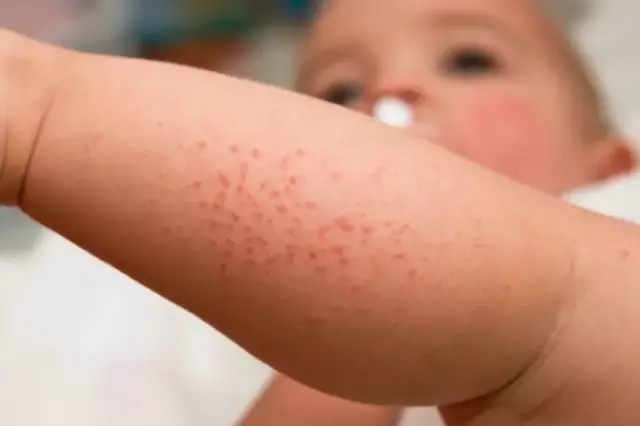- Author Rachel Wainwright [email protected].
- Public 2023-12-15 07:39.
- Last modified 2025-11-02 20:14.
Vulvovaginitis
The content of the article:
- Causes of vulvovaginitis and risk factors
- Forms of the disease
- Symptoms of vulvovaginitis
- Features of the course of vulvovaginitis in children
- Diagnostics of the vulvovaginitis
- Treatment of vulvovaginitis
- Possible complications and consequences
- Forecast
- Prevention
Vulvovaginitis is an inflammation of the mucous membranes of the external female genital organs and vagina, which can have both infectious and non-infectious etiology.

With vulvovaginitis, the mucous membranes of the external genital organs become inflamed.
Most often, vulvovaginitis is diagnosed in girls under ten years old, as well as in postmenopausal women, due to the peculiarities of age-related physiology. The peak incidence occurs at the age of 3-7 years. The prevalence is high - in the general structure of gynecological pathology, the share of vulvovaginitis is 60-80% of all cases.
The urgency of the problem of vulvovaginitis lies in its torpid course, a tendency to relapse and transition to a chronic form, which is less responsive to treatment, the possibility of involving other organs of the genitourinary tract in the inflammatory process, as well as the possible development of long-term consequences in relation to reproductive function.
Causes of vulvovaginitis and risk factors
The main cause of vulvovaginitis is infection. In girls under ten years of age, the most common pathogens are non-specific bacterial microflora (Staphylococcus aureus, diplococci, enterococci, Escherichia coli, chlamydia, anaerobic microorganisms), in women of reproductive age, microscopic yeast-like fungi of the genus Candida are added to this list.

The cause of vulvovaginitis in women of reproductive age is the fungus Candida
Unprotected sex can cause the development of vulvovaginitis with genital herpes, as well as chlamydia, trichomoniasis and other infectious diseases that are sexually transmitted. Diphtheria lesions of the vagina and vulva can develop after suffering pharyngeal diphtheria (the pathogen is transferred from the primary focus with blood flow). There is vulvovaginitis against the background of genital tuberculosis, helminthic invasions.
In addition to infection, a prerequisite for the development of the disease is a decrease in local and / or general immunity.
The development of vulvovaginitis in children is often due to insufficient hygiene, alkaline pH of vaginal secretions. In postmenopausal women, the main reason for the development of vulvovaginitis is a physiological decrease in estrogen levels, leading to a decrease in the secretion of vaginal secretions, which performs a protective function, and a change in the vaginal microflora.
Recurrent forms of vulvovaginitis develop in patients with endocrine disorders and metabolic diseases, intestinal dysbiosis, and diseases of the urinary system.
Risk factors include:
- stress;
- trauma to the vulva and / or vagina;
- pregnancy;
- the use of a number of drugs (antibiotics, cytostatics, glucocorticosteroids);
- hemorrhoids;
- uterine bleeding;
- genital prolapse;
- immunodeficiency states;
- eczema of the skin of the perineum.
Vulvovaginitis in newborns usually develops as a result of infection during the passage of the birth canal of an infected mother. In addition, transplacental infection of the fetus is possible, in particular, with viral vulvovaginitis.
Forms of the disease
Depending on the etiology and characteristics of the clinical picture, vulvovaginitis is divided into forms:
- primary non-infectious (traumatic, allergic, dysmetabolic, dyshormonal);
- primary infectious.
Primary infectious vulvovaginitis, in turn, is classified into:
- nonspecific (coccal-bacillary);
- specific (chlamydial, trichomonas, gonorrheal, cytomegalovirus, tuberculous, candidal, etc.).
Depending on the age factor of the patients, there are three main groups:
- vulvovaginitis in girls;
- vulvovaginitis in women of reproductive age;
- vulvovaginitis in postmenopausal women.
Depending on the duration, vulvovaginitis is:
- acute - up to one month;
- subacute - up to three months;
- chronic - over three months.
Depending on the nature of the course, chronic vulvovaginitis can be persistent (permanent) and recurrent (exacerbations are replaced by remissions).
Symptoms of vulvovaginitis
The clinical picture of acute vulvovaginitis is characterized by signs of a local inflammatory process. Patients complain of itching, burning, soreness in the area of the external genital organs and small pelvis, which are aggravated by walking, urination, during intercourse. The itching sensation in the genitals can cause scratching and further bacterial infection of the damaged area. When examining the external genital organs, hyperemia of the vulva, swelling of the labia, maceration of the skin of the perineum and thighs is determined.

Women with vulvovaginitis complain of itching, pain and burning sensation in the genital area
An increase in body temperature and an increase in regional lymph nodes with vulvovaginitis are rare, mainly found in patients with immunodeficiency of one or another etiology.
Pathological discharge from the urogenital tract in acute vulvovaginitis can be scanty or abundant, and also have a serous-purulent, purulent, cheesy, bloody character and an unpleasant odor.
In the case of a severe course of the disease, erosion develops on the external genital organs, which contributes to the addition of a secondary bacterial infection.
With the transition of the disease to a chronic form, the symptoms of vulvovaginitis subside, become less pronounced, and sometimes disappear completely - however, in this case, this is not a sign of recovery. Patients may be disturbed by vaginal discharge with an unpleasant odor, itching in the genitals, discomfort during intercourse. In the case of a prolonged course of the disease, hyperemia in the affected area is replaced by pigmentation. Exacerbations of the inflammatory process occur during hypothermia, against the background of gross errors in nutrition (abuse of sweets, spicy, spicy, fatty foods), after suffering from acute respiratory infections. With the progression of the disease in the absence of treatment, the formation of cicatricial adhesions in the vagina is possible, which negatively affects the patient's sex life.
Features of the course of vulvovaginitis in children
For vulvovaginitis in children, an acute course is characteristic, however, the chronicity of the disease often occurs.
Local signs of inflammation are usually pronounced, often accompanied by pain in the lower abdomen, pain can radiate to the sacro-lumbar region. Little girls try to hold back urination because of its pain. The general condition suffers - appetite decreases, the child becomes moody, sleep is disturbed. Dysuric phenomena, constipation may occur.

In children, vulvovaginitis occurs in an acute form and is accompanied by pain in the lower abdomen
With the transition of vulvovaginitis into a chronic form, synechiae of the labia minora can form (adhesion all over or in the lower third), which creates obstacles to urination, and in the future can lead to the development of secondary cystitis, violations of sexual and reproductive function.
Diagnostics of the vulvovaginitis
The primary diagnosis of vulvovaginitis is based on the data obtained during the collection of complaints, anamnesis and an objective examination of the patient. In order to confirm the diagnosis, develop therapeutic tactics, as well as carry out differential diagnostics, a number of instrumental and laboratory tests are carried out.
The main instrumental method is colposcopy (in childhood - vaginoscopy) and cervicoscopy.

The main method for diagnosing vulvovaginitis is colposcopy
An increased number of leukocytes and the detection of an infectious agent are in favor of the inflammatory process. The causative agent is detected during microscopy of smears, as well as bacteriological examination of material (smears, washings, scrapings) from the urogenital tract. To identify the pathogen, they also resort to the polymerase chain reaction of scraping. The highly specific studies used to diagnose vulvovaginitis include immunofluorescence analysis.
A general urine test is prescribed, as well as a study for enterobiasis (especially for pediatric patients).
In order to exclude inflammatory diseases of the uterus and appendages, an ultrasound examination of the pelvic organs is performed.
To clarify the diagnosis, you may need to consult a dermatovenerologist, urologist, endocrinologist, allergist, phthisiatrician.
Treatment of vulvovaginitis
Treatment of vulvovaginitis is carried out without fail regardless of the etiology, age of the patient and the severity of symptoms. An important condition for the success of therapy is the elimination of the action of adverse factors that contributed to the development of the disease.
Etiotropic treatment of vulvovaginitis consists in the use of anti-infectious drugs. For this, local (in the form of a cream, suppositories, vaginal tablets) and systemic preparations of antibacterial, antiviral, antifungal action are usually prescribed, the selection of which is carried out depending on the type of infectious agent and its sensitivity determined during laboratory diagnostics. In most cases, local therapy is sufficient.
Due to the relatively high prevalence of polymicrobial vulvovaginitis, multicomponent drugs can be prescribed, which provide local antibacterial, antifungal and antiprotozoal effects.

In most cases, local treatment of vulvovaginitis is sufficient.
In the course of further treatment of vulvovaginitis, in order to accelerate epithelialization, ointments are used, which include vitamins A and E, as well as other reparative drugs.
It is possible to reduce the severity of symptoms of vulvovaginitis against the background of the main treatment with the help of sedentary baths and douching with infusions of medicinal herbs (chamomile, calendula, St. John's wort, sage, nettle, mint) and solutions of pharmaceutical antiseptics. After the acute inflammation subsides, physiotherapy (phonophoresis of drugs, laser therapy) may be appropriate.
Patients with vulvovaginitis are shown a balanced diet with the exclusion of heavy and irritating foods (fatty, fried, pickled foods, smoked meats, spicy, spicy foods, confectionery) from the diet.
During the treatment of vulvovaginitis, you must refrain from sexual intercourse. If the patient develops a specific vulvovaginitis, treatment of all sexual partners is required.
Control of recovery after a course of therapy is carried out by conducting a microbiological and bacterioscopic analysis of the discharge from the urogenital tract.
Possible complications and consequences
In the absence of timely adequate treatment of vulvovaginitis, inflammatory processes of the upper parts of the urogenital tract, cervical erosion, endometritis, hypoxia of the vaginal walls, as well as miscarriage, ectopic pregnancy, infertility can develop.
Forecast
With timely diagnosis and properly selected treatment, the prognosis is favorable.
Prevention
In order to prevent vulvovaginitis, it is recommended:
- carefully observe the hygiene of the genitals, but keep in mind that excessive use of hygiene products (soap, shower gel) can also contribute to the development of inflammation;
- avoiding promiscuous and unprotected sex;
- avoid hypothermia;
- lead a healthy lifestyle;
- wear underwear made from natural materials.
YouTube video related to the article:

Anna Aksenova Medical journalist About the author
Education: 2004-2007 "First Kiev Medical College" specialty "Laboratory Diagnostics".
The information is generalized and provided for informational purposes only. At the first sign of illness, see your doctor. Self-medication is hazardous to health!






